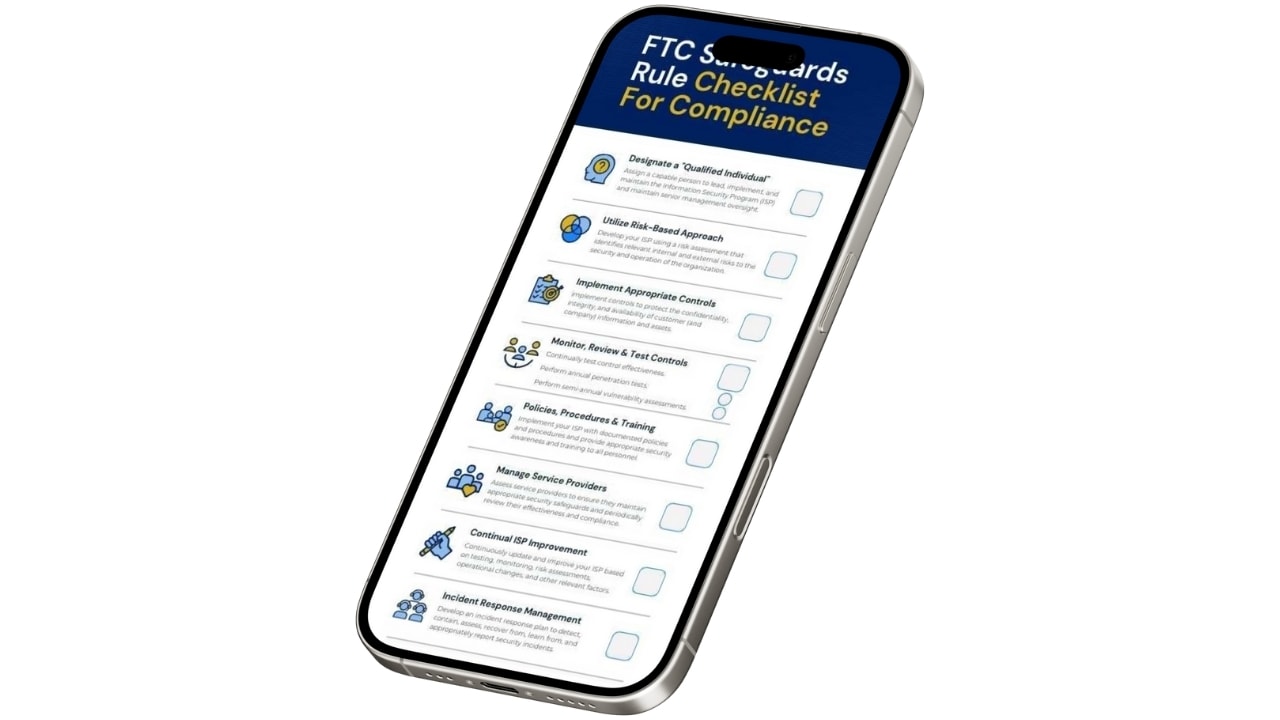FTC Safeguards Rule Checklist for Compliance: Continual ISP Improvement
Apr 17, 2025
Let’s face it: cybersecurity can feel like a never-ending series of hurdles, complete with regulatory jargon, endless acronyms, and the occasional panic-induced coffee break. But rest assured, navigating the digital labyrinth doesn’t have to cause sleepless nights. Welcome back to our FTC Safeguards Rule Checklist series, your trusty guide designed specifically to simplify compliance and demystify data security.
In today’s digitally driven world, protecting customer data isn’t just good business—it’s a legal necessity. Identifying and protecting critical assets within an organization as part of security risk assessments and policy development is essential for prioritizing risks and ensuring effective implementation of security controls. Our checklist series tackles this head-on, providing businesses with clear, actionable steps that align with the FTC Safeguards Rule. By slicing the compliance pie into bite-sized, manageable pieces, we help you safeguard sensitive information effectively and without headaches.
Information Security Programs - A Quick Primer & Important Components
Information security is a critical aspect of any organization, particularly for financial institutions that handle sensitive customer information. The Federal Trade Commission’s (FTC) Safeguards Rule requires covered financial institutions to develop, implement, and maintain an information security program to protect customer information. This program must include administrative, technical, and physical safeguards designed to ensure the confidentiality, integrity, and availability of customer information. Effective information security policies and procedures are essential for maintaining an organization’s security posture and preventing data breaches.
The FTC Safeguards Rule mandates that financial institutions take a proactive approach to information security. This means not only setting up robust security measures but also continuously monitoring and improving them. By doing so, organizations can better protect customer information from unauthorized access and potential data breaches. Remember, a strong information security program is not just about compliance; it’s about building trust with your customers and safeguarding your business’s reputation. Important components for every information security program include:
Data Management Policy
A data classification and management policy is a crucial component of an organization’s information security program. It outlines the procedures for handling, storing, and transmitting sensitive customer information. The policy should include guidelines for data classification, access controls, and data retention. Organizations must ensure that they have appropriate safeguards in place to protect customer information, including encrypting customer information and using multi-factor authentication.
Organizations must also periodically review access controls to ensure that they are adequate to protect customer information. This means regularly assessing who has access to sensitive data and ensuring that only authorized users can access it. By implementing a comprehensive data management policy, financial institutions can better manage their data, reduce the risk of data breaches, and ensure compliance with federal regulations.
Network Security Measures

Appropriate policies and security measures for how to transmit customer information are essential for preventing unauthorized parties from accessing customer information and corporate data. This includes implementing firewalls, intrusion detection systems, and encryption technologies to prevent unauthorized access to sensitive customer information. Organizations must also ensure that they have incident response policies and procedures in place to respond to keep customer information secure and prevent data breaches.
Incident Response Policy
Incident management policies (or data breach policies) are critical components of an organization’s information security program as well as a regulatory compliance requirement. These policies outline the procedures for responding to security events and incidents (data breaches), including notification procedures, containment procedures, and eradication procedures. Financial institutions must ensure that they have a written incident response plan in place that includes procedures for detecting unauthorized access, responding to security events, and notifying affected customers.
The FTC Safeguards Rule requires covered financial institutions to report security incidents to the Federal Trade Commission. This means that in the event of a data breach, financial institutions must not only take steps to mitigate the impact of the breach but also comply with regulatory reporting requirements.
Follow Along with the FTC Safeguards Rule Compliance Checklist

You’re currently cruising through our ongoing series covering the FTC Safeguards Rule, a journey broken down into easy-to-follow checkpoints designed to streamline your compliance process. Whether you’re proactively building your security program from scratch or meticulously tightening screws ahead of an audit, our checklist ensures you remain organized, clear-headed, and confidently compliant. It is essential to implement procedures and standards that provide employees with clear directions on how to adhere to these policies.
For those who appreciate a visual roadmap—because, let’s be honest, who doesn’t—we’ve crafted an engaging infographic checklist. It distills critical compliance steps into a visual format that’s both intuitive and actionable. Think of it as your digital co-pilot for ensuring no vital security measure is overlooked.
👉 Download the FTC Safeguards Rule Checklist Infographic to follow along seamlessly.
What Is the FTC Safeguards Rule?
Let’s rewind slightly. The FTC Safeguards Rule, an offspring of the Gramm-Leach-Bliley Act (GLBA), was originally introduced back in 2003 when the internet was simpler, threats were fewer, and “cybersecurity” barely registered on the corporate radar.
Fast forward to today—cyber threats are multiplying faster than memes on social media, prompting a substantial 2021 revamp of the Rule. The revised Safeguards Rule demands businesses maintain comprehensive, documented, and enforceable cybersecurity programs aimed squarely at protecting Nonpublic Personal Information (NPI). These amendments provide more concrete guidance with specific, actionable requirements that businesses must follow to protect customer information. Simply put, the FTC expects you to have an ongoing, adaptable security plan that keeps customer data out of the wrong hands—no exceptions.
Who Has to Comply?

Contrary to popular belief, you don’t have to be running a financial mega-corporation to find yourself under the FTC’s microscope. If your organization touches financial data, even tangentially, you’re likely labeled a “financial institution” by FTC standards. These entities engage in activities that are financial in nature or incidental to such financial activities.
This includes businesses like:
-
CPA and tax preparation firms
-
Mortgage brokers
-
Auto dealerships offering financing
-
Credit repair companies
-
Non-SEC regulated investment advisors
-
Payday lenders
-
Personal property appraisers
In short, if your company handles financial information in any form, you’re officially part of the compliance club. Welcome aboard; the coffee is always brewing.
📋 FTC Safeguards Rule: Core Requirements
To stay compliant with the Rule, here’s what you’re obligated to handle:
-
Appoint a Qualified Individual to oversee security (16 CFR § 314.4(a))
-
Develop and document a risk-based security plan (16 CFR § 314.4(b))
-
Implement security measures addressing identified risks (16 CFR § 314.4(c))
-
Regularly monitor, review, and test security controls (16 CFR § 314.4(d))
-
Provide security awareness training for employees (16 CFR § 314.4(e))
-
Manage service provider security diligently (16 CFR § 314.4(f))
-
Continually improve your security program (16 CFR § 314.4(g)) <-- We are here!
-
Maintain an incident response plan (16 CFR § 314.4(h))
-
Comply with breach notification mandates
-
Regularly report security status to your board (16 CFR § 314.4(i))
Continuous Improvement: A Never-Ending Journey (16 CFR § 314.4(g))
Here’s the uncomfortable truth: cybersecurity is never “finished.” It's an ongoing, dynamic process—much like updating software or, dare we say, trying to keep plants alive at the office. The FTC explicitly mandates continuous evaluation and improvement of your Information Security Program (ISP).
Adjustments Based on Testing and Monitoring Results
Effective testing and monitoring—outlined clearly in 16 CFR § 314.4(d)—will inevitably reveal vulnerabilities or shortcomings in your security measures. Don’t see this as a weakness; consider it an opportunity to fortify your digital defenses. Analyze test results critically and adjust your ISP accordingly, ensuring your defenses evolve to handle emerging threats and discovered gaps. Continuous monitoring is essential to detect actual and attempted attacks, maintaining system security and effectiveness.
Responding to Operational and Business Changes

Changes in your business aren’t merely operational blips—they're potential security earthquakes. If you’ve recently expanded services, merged with another entity, or embraced remote work on a larger scale, your risk profile has changed significantly. FTC compliance isn't about static policies; it's about proactive adaptation. Every major business shift warrants a thoughtful reassessment of your ISP to ensure it aligns with current realities.
Risk Assessments as a Compass
Written risk assessments, mandated by 16 CFR § 314.4(b)(2), aren't bureaucratic busywork—they’re your compass for navigating cybersecurity decisions. Consistently performing risk assessments and acting on findings is vital. Risks evolve, and so should your responses. Regularly integrate new findings into your ISP adjustments, ensuring your security measures are tailored precisely to your current risk landscape.
Material Impact and Other Circumstances
Beyond scheduled assessments and obvious business shifts, occasionally life throws curveballs—cyber incidents at competitors, new legislation, or unforeseen global events (remember the overnight shift to remote work?). Stay vigilant and proactively integrate lessons learned from external sources into your ISP. The FTC expects you to anticipate issues—not merely react to them.
Building a Culture of Continuous Improvement

Continuous improvement isn't just about ticking boxes—it’s a cultural shift within your organization. Encourage open discussions about cybersecurity, regularly seek employee input, and foster an environment where staff feel empowered to report concerns or propose improvements. Your employees are frontline warriors against cyber threats; equip and engage them accordingly.
Documentation: Your ISP's Best Friend
Finally, document everything—seriously, everything. Adjustments, assessments, testing outcomes, and decision-making processes should all be meticulously recorded. Documentation doesn’t just satisfy FTC auditors—it gives you a strategic overview to pinpoint progress, identify recurrent weaknesses, and maintain clarity about your security evolution over time.
🧰 How Input Output Can Support Your Security Evolution
Keeping pace with compliance while juggling day-to-day operations can feel like building a plane while flying it. That’s where we come in—ready to help you not only meet the standards of 314.4(g), but confidently maintain and improve your information security program over time.
Here’s how we partner with you to keep your program effective and ever-improving:
📄 Policies, Contracts, and Control Clarity
-
Pre-built policy templates for everything from vendor management to data security
-
Legal-ready contract language for processing and confidentiality requirements
-
Due diligence and access control forms to formalize vendor oversight
-
Access governance templates that define and limit permissions to only what’s necessary. These policies encompass the management and protection of not only sensitive data but also the organization's systems, networks, and infrastructure.
🔍 Risk & Program Assessments
-
Evaluate current program performance and vendor oversight practices. An information security system is a structured set of electronic resources essential for the collection, processing, and management of information related to customers.
-
Spot high-risk areas and flag gaps in controls or policy
-
Map findings to FTC requirements with clear, prioritized fixes
📊 Oversight & Audit Support
-
Tools and templates for routine reassessments
-
Frameworks for annual reviews and third-party evaluations
-
Documentation support that makes audits far less scary (and a lot more successful).
🎓 Awareness Training & Social Engineering Drills
-
Fully managed training platforms to keep your team sharp and security-aware
-
Simulated phishing, vishing, smishing, quishing, and other “fun” social engineering tests
-
Trackable engagement and compliance reports to prove you’re on top of your game.
✅ Full-Service WISP Development
-
Whether you’re starting from scratch or refreshing a dusty binder, we help build a comprehensive Written Information Security Program
-
Clear alignment with FTC expectations and a strategic path to maturity
Need a partner that makes compliance feel less like a chore and more like a win? Let’s talk. We’re here to help you build smart, stay secure, and sleep better.
Wrapping It Up
Embracing continuous improvement is critical—not just for compliance, but for your organization's overall resilience. Regularly evaluate your ISP, adapt proactively, and treat cybersecurity as a journey rather than a destination.
Stay tuned for our next checklist installment. Until then, remember: in cybersecurity, as in life, adaptability isn’t just beneficial—it’s essential.
STAY INFORMED
Subscribe now to receive the latest expert insights on cybersecurity, compliance, and business management delivered straight to your inbox.
We hate SPAM. We will never sell your information, for any reason.
